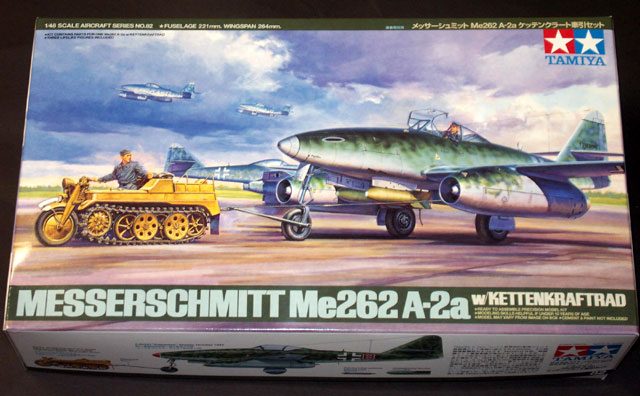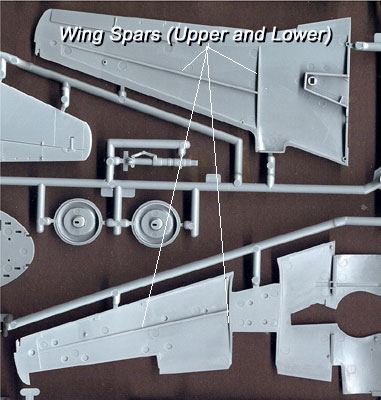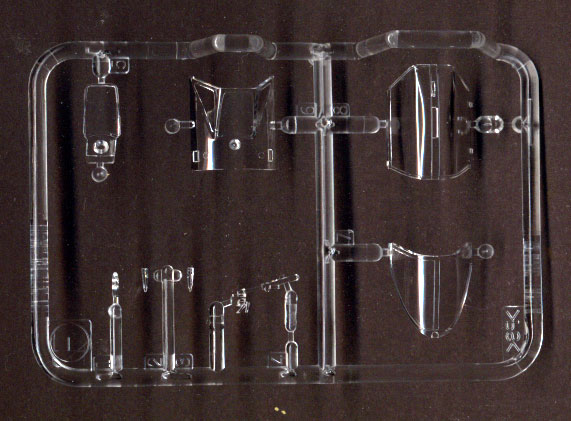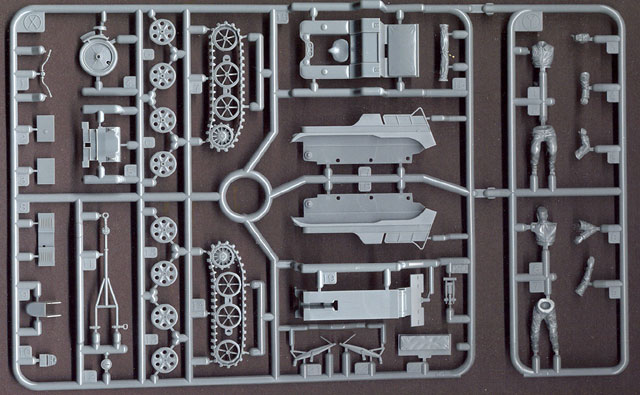|
Messerschmitt
Me 262A-2a

Tamiya

Tamiya's 1/48 scale Messerschmitt Me 262A-2a be ordered online from Squadron.com
S
u m m a r y
|
| Catalogue Number: |
61082 |
| Scale: |
1/48 |
| Contents and Media: |
144 parts in grey styrene;
8 parts
in clear styrene; 1 part in cast metal |
| Price: |
USD$39.96
from Squadron.com |
| Review Type: |
First Look |
| Advantages: |
Accurate dimensions and shape;
Kettenkrad, tow-bar and three figures included; excellent surface
features; high level of detail; useful options; simple parts breakdown and
construction; intelligent engineering. |
| Disadvantages: |
No alternative positions for control
surfaces (slats and flaps in particular); only two-gun nose offered; some
shallow ejector pin marks. |
| Recommendation: |
Highly Recommended |
Reviewed by
Brett Green
Tamiya's latest release is the first all-new 1/48 scale Messerschmitt
Me 262 to hit the market in 13 years. The first variant is the Me
262A-2a fighter/bomber version with two 30mm MK108 cannon in the nose.
The Me 262A-2a
was also observed with four MK108 cannon, but this option is not offered
in the kit.
Me 262A-2a In The Box
Tamiya's 1/48 scale Me 262A-2a comprises 116 parts in grey styrene, 8
parts in clear styrene and one white metal piece for the forward landing
gear bay that doubles as a hefty noseweight.
The contents of this box reinforce Tamiya's reputation for superb
detail, intelligent engineering and simple construction.
Panel lines are crisply engraved, while
the interior features raised structural detail. This
is especially important inside the fuselage, which is almost completely
exposed above the open main undercarriage bay. The purpose of the
structural detail (and the large locating holes) inside the engine nacelles is less obvious, but I suspect that we might see a "clear
plastic" version of the kit with visible Jumo 004s in the future.
Also, the inside of the forward upper engine access hatches are heavily
engraved, making it a simple matter to cut these hatches open for a
limited view of the jet powerplants.
Click the thumbnails below
to view larger images:
The cockpit is well detailed in the usual Tamiya style, with blank
instrument faces for decal dials, and a decal harness for the seat. The
cockpit tub includes exterior detail for the forward and rear bulkheads
plus prominent actuator rods. The cannon bay is simple in breakdown but
equally well detailed. Four shell ejector ports are supplied on two
separate inserts for the lower nose. The upper and lower joins for these
inserts should be filled and sanded as they do not fall on natural panel
lines.
The nose gear bay is a white metal part. This will ensure that no
additional weight is required to prevent the model becoming a
tail-sitter. One of the options is alternative nose wheels - one smooth
and one with a radial tread.
 Wings are supplied as a full-span lower section, and separate parts
for the upper right and left halves. Flaps and slats are moulded in the
closed (up) position. The interior of the wings are reinforced with
moulded-on spars that run widthwise and lengthwise. These spars have
been carefully designed not to intersect with the flaps or slats. This
means that, if the modeller chooses to reposition the flying surfaces
themselves, the wings will maintain their rigidity and correct chord
even after the flaps and slats have been cut off. Wings are supplied as a full-span lower section, and separate parts
for the upper right and left halves. Flaps and slats are moulded in the
closed (up) position. The interior of the wings are reinforced with
moulded-on spars that run widthwise and lengthwise. These spars have
been carefully designed not to intersect with the flaps or slats. This
means that, if the modeller chooses to reposition the flying surfaces
themselves, the wings will maintain their rigidity and correct chord
even after the flaps and slats have been cut off.
Horizontal tail surfaces are keyed, ensuring
positive fit. Another nice touch is the inclusion of separate,
delicate trim tab actuators on the elevators.
Two 250kg bombs and two styles of bombracks are also included.
An added little bonus is the optional Rocket Assisted Take-Off pods
for the lower fuselage. The choice of open or closed
cannon access hatches is also offered. The open option supplies a single part with both
hatches fixed up, and two separate supporting struts.
The windscreen is cleverly moulded with a section of the
forward upper fuselage deck. The vertical and horizontal joins both fall
on panel lines. Furthermore, the internal armoured glass is a separate
part that is glued to a locating pin under the front deck section. This
will minimise the risk of messing up the windscreen with glue spots. The
opening centre section of the canopy is similarly thoughtful. Two tabs
are attached to the starboard side of the canopy to secure it in the
open position. These tabs should be removed if the canopy is to be
displayed closed.

Instructions are called out over 16 illustrated steps. Colour
suggestions seem to be reasonable, however the interior of the cannon
bay covers were RLM 02 Grey on some Me 262s, not bare-metal silver
as noted in the instructions.
Markings are supplied for three Stormbirds of KG 51. I was especially
pleased that the narrow borders for the coloured nose and fin caps were supplied
in decal form. This will save a tricky masking job.
But wait - there's more!
Sd.Kfz. 2 Kleines
Kettenkraftrad In The Box
In addition to the aircraft, Tamiya includes a 1/48 scale Sd.Kfz. 2
Kleines Kettenkraftrad. This was a general purpose tracked motorcycle
that was sometimes used to tow various aircraft on Luftwaffe airfields.
Considering the short life of the Me 262 engines, it is reasonable to
expect that the Stormbird would be towed more frequently than
propeller-driven aircraft. The Kettenkraftrad comprises only 29
additional parts in grey styrene.
The parts breakdown is extremely simple for this little tractor. The
drive sprocket, idler wheel and centre road wheels are moulded in the
centre of the tracks as a clever, single part for each side. Two
additional roadwheels are added to the left and right sides to complete
a simple but convincing set of running gear. In a similar feat of
simplicity, the front wheel is moulded with the mudguard, number plate
and Notek light in place.
This simple engineering has not compromised the crisp surface detail.
Even the fabric textures of the rear seat and the folded cover are well
communicated.

The towbar does not require glue, enabling the Kettenkraftrad to be
positioned or removed at the modeller's whim. A set of two removable
engine intake covers for the Me 262 further enhances the diorama
potential of this kit.
Three figures complete the package. One is a standard Tamiya-style
pilot with headgear seated in the flying position. The second figure is
also a seated pilot. However, this chap is holding the canopy open with
one hand, with his other arm resting on the canopy sill while he leans
his head out of the cockpit. The final figure compliments this taxiing
pilot as the driver of the Kettenkraftrad, looking back over his
shoulder to the towed Stormbird.
In my opinion, this is the best Messerschmitt Me 262 kit ever
released.
Comparisons with other kits is inevitable. Indeed, the comparisons
and criticism started well before the kit was released. The most valid
comparison is with the Trimaster-derived 1/48 scale Me 262 kits. The
Trimaster kits were subsequently released under the labels of Dragon,
DML, Revell and Italeri. I compared my new Tamiya kit with one of my
small stash of Trimaster Me 262 variants. In a one-on-one shootout, the
Tamiya kit narrowly wins in the detail department (with crisper surface
features and better interior detail) and is clearly superior to the
Trimaster kit in engineering finesse. The Tamiya kit also does not
suffer from the terrible, styrene-eating vinyl tyres of the Trimaster/Dragon
kits!
More importantly, having wrestled with one of the Dragon-boxed Me 262
some years ago, I just know that the Tamiya kit will be much
easier to build.
Another frequent criticism of the new Tamiya kit is the absence of
separate slats and flaps. Neither the Trimaster-derived nor Monogram
kits had this feature either, so it is a moot point of comparison as far
as I am concerned. However, it is true that most, if not all,
operational Me 262s were observed with dropped slats. The after-market
is certain to offer separate flaps and slats for this kit in the coming
weeks, and the inbuilt spars in the wings of the Tamiya kit will make
the task less complicated for the modeller.
It is almost certain that this kit is the first in a family of Tamiya
Stormbirds. At the very least we can expect to see the Me 262A-1a day
fighter version in the future. If you can't wait for Tamiya to release
the kit, one resin manufacturer has already announced a simple
conversion.
Tamiya's new 1/48 scale Messerschmitt Me 262 is well detailed,
cleverly engineered and has plenty of useful options. The inclusion of
the Kettenkraftrad, the figures and the intake covers all enhance the
display options for this very attractive kit.
Will I be throwing out my stash of Trimaster and Dragon Me 262s? No.
I won't even be selling them cheaply.
But I will be building my Tamiya Me 262 before I build them!
Highly Recommended.
Purchased with the
Editor's own funds
Review and Images Copyright © 2002 by Brett
Green
Page Created 15 April, 2002
Last updated 22 July, 2003
Back to HyperScale Main Page
Back to Reviews Page
|
Home | What's
New | Features
| Gallery |
Reviews | Reference
| Forum
| Search